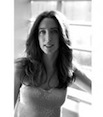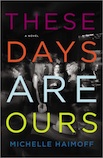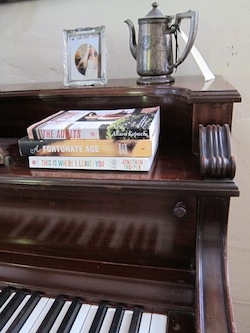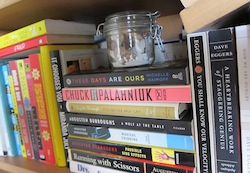
 Michelle Haimoff, author of THESE DAYS ARE OURS, shares her book-shelving methods, including one tip that will be especially useful for or west coast readers: Earthquake Practicality.
Michelle Haimoff, author of THESE DAYS ARE OURS, shares her book-shelving methods, including one tip that will be especially useful for or west coast readers: Earthquake Practicality.
For as long as I can remember, my fantasy has been to live in a home that is one big fire hazard. Bookshelves everywhere, stuffed with thousands of brittle soft covers. I get closer to this fantasy with every move. The most recent one, when my now husband and I moved in together, doubled my book collection. We have three huge bookshelves and piles of books in every room (including the kitchen, which has about 30 cookbooks we never use because of Google).

He’s a tech guy so he gets to decide what technology we should have in the house. Suffice it to say, I don’t know how to turn on the TV. I had finally learned how to use the all-in-one remote after a year of trial and error, but then last weekend we received a newer, better all-in-one remote as a wedding gift (whi
ch, come to think of it, I don’t remember registering for) and now I watch Hulu on my laptop again.
I’m a writer so I get to decide how we shelve books. In Los Angeles, where we live, there are two considerations that come into play when shelving books:
1. Literary category
2. Earthquake practicality
Ben still has a bunch of computer science textbooks from college. Those all go on the bottom shelf. Yes they’re boring, but more importantly they’re heavy, and when I get toppled by a bookshelf in an earthquake, I’d prefer to be strangled slowly by lightweight fiction. The other book category he has is business books. WHO MOVED MY CHEESE? and that sort of thing. Those aren’t as heavy but they’re on the bottom shelf too.
 My most treasured shelf is the shelf with my favorite books: Everything by J.D. Salinger, Antoine de Saint-Exupery, Bret Easton Ellis and Ayn Rand (don’t judge). My other treasured bookshelf includes the books that taught me how to write: books by Dave Eggers, Augusten Burrows, Miranda July and Nick Hornby. There is also a short stack on our piano of books written by authors that have blurbed me. I’ve learned that getting a blurb from a published author is one of the most important parts of the book publicity process, so in our home they get the place of honor a photo of a grandchild might have.
My most treasured shelf is the shelf with my favorite books: Everything by J.D. Salinger, Antoine de Saint-Exupery, Bret Easton Ellis and Ayn Rand (don’t judge). My other treasured bookshelf includes the books that taught me how to write: books by Dave Eggers, Augusten Burrows, Miranda July and Nick Hornby. There is also a short stack on our piano of books written by authors that have blurbed me. I’ve learned that getting a blurb from a published author is one of the most important parts of the book publicity process, so in our home they get the place of honor a photo of a grandchild might have.
Other shelf categories include contemporary fiction, books about religion, books about the Jewish experience, books about the black experience, books about feminism, coming-of-age novels, poetry, plays, short stories, graphic novels and art books. I should have other “cultural experience” categories on my shelves, and for that I blame my high school curriculum. However, I’ve slowly been building a Mexican experience section, and I look forward to becoming less of an ignoramus about other cultures too. Aside from books about feminism, I read very little nonfiction.
 In the instances where Ben and I owned the same books, my versions won out because I always underlined --- and because I was in charge of books. I actually have no problem with repeats as long as they’re not the exact same edition. I own multiple copies of Salinger’s books. I love the cover of the 50-cent Signet edition of THE CATCHER IN THE RYE, which reads: “This unusual book may shock you, will make you laugh, and may break your heart - but you will never forget it.” And I also buy books in different languages. I have copies of THE LITTLE PRINCE in Hebrew, French, German and Russian.
In the instances where Ben and I owned the same books, my versions won out because I always underlined --- and because I was in charge of books. I actually have no problem with repeats as long as they’re not the exact same edition. I own multiple copies of Salinger’s books. I love the cover of the 50-cent Signet edition of THE CATCHER IN THE RYE, which reads: “This unusual book may shock you, will make you laugh, and may break your heart - but you will never forget it.” And I also buy books in different languages. I have copies of THE LITTLE PRINCE in Hebrew, French, German and Russian.
I think used books are just about the most beautiful objects in the world and I feel lucky to feel this way about something that is so relatively inexpensive. To be honest, I haven’t read a conservative half of the books on these shelves, but I love having the library. There’s something sturdy about books. Even if they keep me from ever being able to move again, even if they increase my likelihood of getting killed in an earthquake or a fire, books make anywhere I’ve ever lived feel like home. It’s a feeling an iPad plugged into a wall just can’t match.


